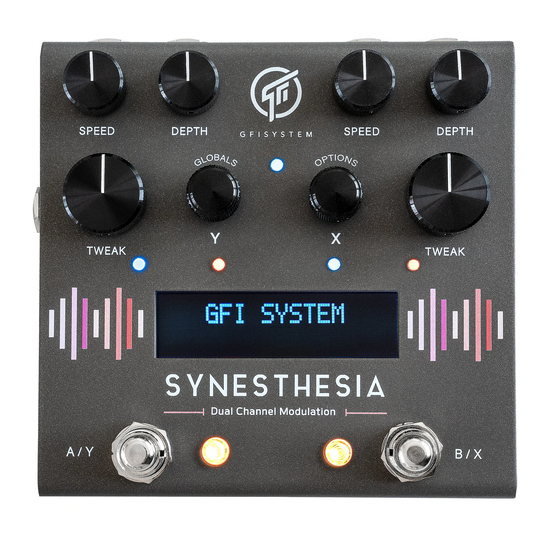
GFI System Synesthesia Quick Manual
Hide thumbs
Also See for Synesthesia:
- Manual (37 pages) ,
- User manual (18 pages) ,
- Quick start manual (2 pages)
Advertisement
Quick Links
SYNESTHESIA
1. PARAMETERS : Primary and Secondary
Each algorithm has up to 6 adjustable parameters. Three parameters are adjusted by turning the SPEED, DEPTH, or TWEAK knobs,
these are the Primary parameters. The other three are adjusted by twisting (press‐turn) the SPEED, DEPTH, or TWEAK knobs, these
are the Secondary parameters.
Only Primary parameters may be ramped or controlled via expression pedal.
2. X‐Y SWAP.
When running 2 algorithms simultaneously, and tweaking them to find the desired settings, there'll be times where you want to
know what would it sound like if the effect order is swapped, this can be very easily accomplished using the X‐Y Swap function :
>>My Preset
TRMOLO << UNIVBE
Both algorithms and parameters setting of each DSP are swapped, thereby preserving the complete state.
3. PRESET MODE vs STOMPBOX MODE.
Synesthesia has 2 modes of operation, Preset Mode and Stompbox mode, and a simple mechanism to quickly switch back and forth
between the two.
3.1 Preset Mode
In this mode, everything you do essentially revolves around 'calling of presets', favorite settings that have been previously saved. Tap
footswitch A/Y to call patch A, and tap footswitch B/X to call patch B. This is great for switching over many different sounds quickly.
This mode is indicated by the ORANGE color of LED A/Y and LED B/X.
3.2 Stompbox Mode
In contrast, Stompbox mode allows you to treat the pedal as two individual stompboxes. The footswitches now act as on/off
switches for the X and Y engines, just like using separate 2 pedals. The footswitches also now support momentary action, i.e. you can
engage the X or Y momentarily by pressing on the footswitch and hold it for as long as you want the algorithm to run.
This mode is indicated by the RED color of LED A/Y and LED B/X.
Toggling between Preset Mode and Stompbox Mode :
Press and hold both footswitches, until all the bank LEDs blinks 3x < the screen will temporarily display the active mode >.
‐ Stompbox Mode ‐
TAP
‐> bypass / engage DSP‐Y
HOLD (when bypassed) for more than 500 ms
‐> engages DSP‐Y momentarily
HOLD (when engaged) for more than 500 ms
‐> engages DSP‐Y ramping.
\1
push X encoder and Y encoder simultaneously
>>Foxchaser
FILTER ++ s&hPHI
QUICK IN‐DEPTH GUIDE
- XY swapped -
UNIVBE << TRMOLO
TAP
‐> bypass / engage DSP‐X
\3
HOLD (when bypassed) for more than 500 ms
‐> engages DSP‐X momentarily
HOLD (when engaged) for more than 500 ms
‐> engages DSP‐X ramping.
( firmware v1.0.2 )
Advertisement

Summary of Contents for GFI System Synesthesia
- Page 1 ( firmware v1.0.2 ) QUICK IN‐DEPTH GUIDE SYNESTHESIA 1. PARAMETERS : Primary and Secondary Each algorithm has up to 6 adjustable parameters. Three parameters are adjusted by turning the SPEED, DEPTH, or TWEAK knobs, these are the Primary parameters. The other three are adjusted by twisting (press‐turn) the SPEED, DEPTH, or TWEAK knobs, these are the Secondary parameters. Only Primary parameters may be ramped or controlled via expression pedal. 2. X‐Y SWAP. When running 2 algorithms simultaneously, and tweaking them to find the desired settings, there’ll be times where you want to know what would it sound like if the effect order is swapped, this can be very easily accomplished using the X‐Y Swap function : >>My Preset - XY swapped - TRMOLO << UNIVBE UNIVBE << TRMOLO push X encoder and Y encoder simultaneously Both algorithms and parameters setting of each DSP are swapped, thereby preserving the complete state. 3. PRESET MODE vs STOMPBOX MODE. Synesthesia has 2 modes of operation, Preset Mode and Stompbox mode, and a simple mechanism to quickly switch back and forth between the two. 3.1 Preset Mode In this mode, everything you do essentially revolves around ‘calling of presets’, favorite settings that have been previously saved. Tap footswitch A/Y to call patch A, and tap footswitch B/X to call patch B. This is great for switching over many different sounds quickly. This mode is indicated by the ORANGE color of LED A/Y and LED B/X. 3.2 Stompbox Mode In contrast, Stompbox mode allows you to treat the pedal as two individual stompboxes. The footswitches now act as on/off ...
- Page 2 2. Configure footswitch B/X to function as tap‐tempo switch, this is done in Globals ( Globals ‐> Footswitch B/X ). 5.1 Tap Division A set of tap‐divide options are provided to make your life easier while working with tap tempo. Tap‐Divide can be set in Options ( Options ‐> Tap.Div X, and Options ‐> Tap.Div Y), and is specified on per preset‐basis. Tap‐Divide options Ignore Tap / Clk 4:1 2:1 1:1 1:2 1:3 1:4 3:4 No tempo change 4x slower 2x slower 2x faster 3x faster 4x faster 4/3x faster When you start tapping the tap‐divide values are displayed on the screen. Tap‐divide value of DSP‐Y Tap‐divide value of DSP‐X No value is shown if : ‐ Tap‐divide is set to “Ignore Tap/Clk” ‐ The algorithm doesn’t have a ‘tempo’ (such as Octave , Envelope Filter, etc). 5.2 Tempo LED. The tempo LED will start blinking only when the tempo of both X and Y are synchronized, and this occurs under two conditions : 1. When you do tap‐tempo. 2. When Synesthesia is receiving a midi clock signal. Ignore Tap/Clk”. Also, at least one of the active algorithms must be tapable and the tap‐divide value is not set to “ Visit our website www.gfisystem.com for full user manual, editor software and warranty registeration. ...










Need help?
Do you have a question about the Synesthesia and is the answer not in the manual?
Questions and answers